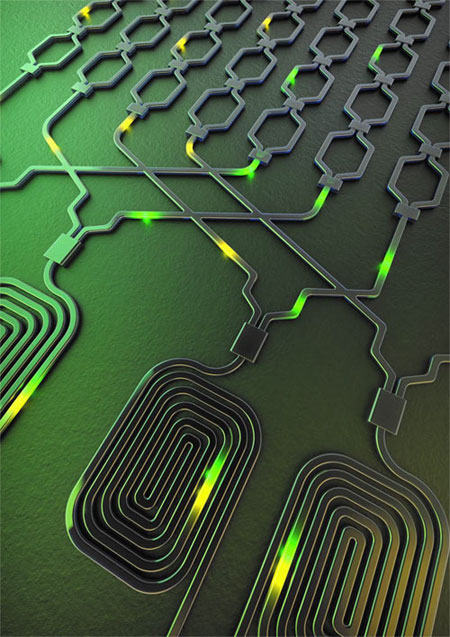BRISTOL, England, Aug. 24, 2018 — An international team led by the University of Bristol has demonstrated the ability to control two qubits of information within a single silicon chip. This programmable two-qubit quantum processor could be used as a tool to perform quantum information experiments and could facilitate the use of silicon photonics for future photonic quantum processors.
To encode the qubits, the researchers used large-scale silicon photonic circuits to guide photons along waveguides. The quantum processor was fabricated with CMOS-compatible processing and comprises more than 200 photonic components.

Waveguides guide photons in silicon, much like an optical fiber. Spirals of these waveguides are used to generate photons that are then routed around the processor circuit to perform different tasks. Courtesy of Xiaogang Qiang/University of Bristol.
The researchers programmed the device to implement 98 different two-qubit unitary operations, a two-qubit quantum approximate optimization algorithm, and efficient simulation of Szegedy-directed quantum walks.
“What we’ve demonstrated is a programmable machine that can do lots of different tasks,” said researcher Xiaogang Qiang.
“It’s a very primitive processor, because it only works on two qubits, which means there is still a long way before we can do useful computations with this technology,” said Qiang. "But what is exciting is that the different properties of silicon photonics that can be used for making a quantum computer have been combined together in one device. This is just too complicated to physically implement with light using previous approaches."
The team believes that its small device built from silicon could be scaled up in a cost-effective way, and emphasizes the importance of building quantum computers from technology that will allow precision on a very large scale. It sees integrated photonics as an alternative to bulky optical elements that could be too large and unstable to be used for the large, complex circuits that will be needed to build quantum computers.
“We need to be looking at how to make quantum computers out of technology that is scalable,” said researcher Jonathan Matthews. "We think silicon is a promising material to do this, partly because of all the investment that has already gone into developing silicon for the microelectronics and photonics industries."
The small quantum processor has become a tool for further research, said the team, who has used the device to implement several different quantum information experiments using almost 100,000 different reprogrammed settings.
“Since there’s been so much research and investment in silicon chips, this innovation might be found in the laptops and smartphones of the future,” said University of Queensland professor Timothy Ralph. “This is just the beginning; we’re just starting to see what kind of exponential change this might lead to.”
The research was published in Nature Photonics (doi: 10.1038/s41566-018-0236-y).